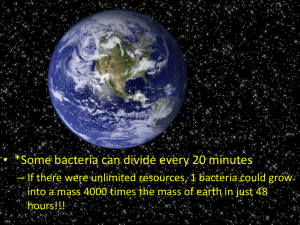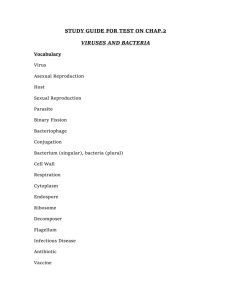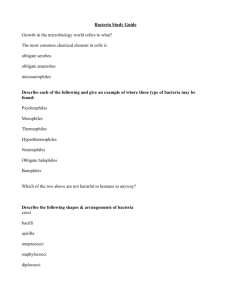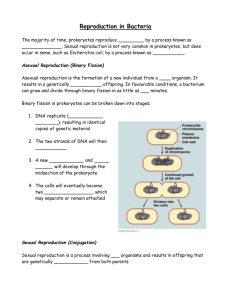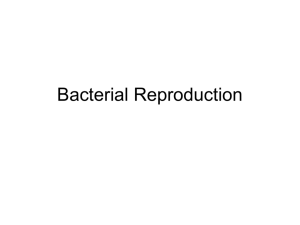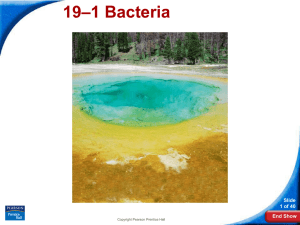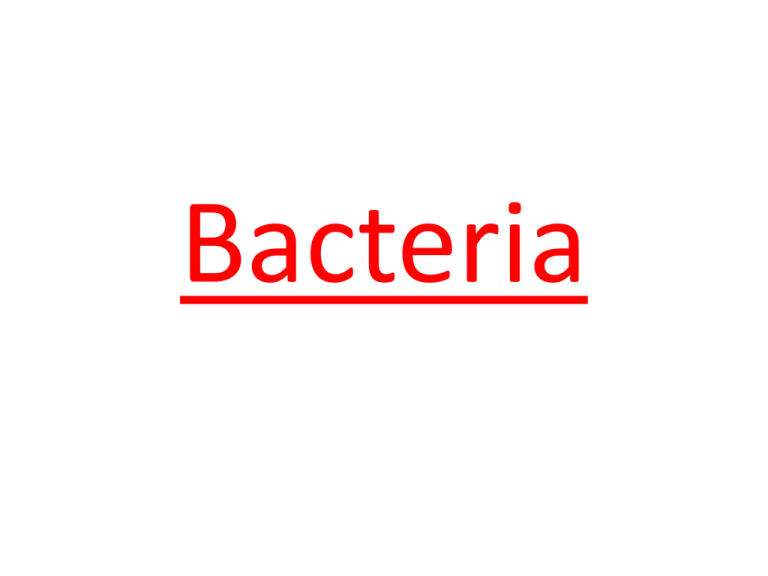
Bacteria
Characteristics
•
•
•
•
prokaryotic
unicellular
usually have locomotion
reproduce sexually & asexually
Classification
Kingdom Archaebacteria – “ancient bacteria”
-able to live in extreme environments
(thick mud, hot springs, salty environments)
Kingdom Eubacteria – “true bacteria”
-many are pathogenic (disease causing)
-ex: E. coli
BACTERIA are classified according
to:
1. Shapes of Bacteria
BASIC SHAPES:
coccus-round, bacillus-rod,
spirillum-spiral
PREFIXES: diplo-pairs, tetra-fours,
staphylo-clusters, strepto-chains
Identifying Prokaryotes
2. Structure of Cell Walls
Two different types of cell walls are found in
eubacteria. A method called gram staining tells them
apart.
Gram-positive bacteria have thinner cell walls with
large amounts of peptidoglycan.
Gram-negative bacteria have thick cell walls inside an
outer lipid layer.
Nutrition
• autotrophic
-photosynthesis – uses light
-chemosynthesis - uses chemicals
• heterotrophic
3. Metabolic Diversity
Prokaryotes are divided into two main
groups:
–Heterotrophs get their energy by
consuming organic molecules made
by other organisms.
–Autotrophs make their own food from
inorganic molecules.ex.
Photoautotrophs and
chemoautotrophs
Metabolic Diversity
Three Types of Metabolism:
a. Obligate aerobes-require a constant supply of
oxygen.
b. Obligate Anaerobes-Bacteria that live without
oxygen because they may be killed by it.
c. Facultative Anaerobes-Bacteria that can
survive with or without oxygen.
4. Reproduction
a. Binary Fission
Binary fission is a type of asexual reproduction in which an
organism replicates its DNA and divides in half,
producing two identical daughter cells.
Copyright Pearson Prentice Hall
Growth and Reproduction
b. Conjugation
During conjugation, a hollow bridge forms
between two bacterial cells, and genes move
from one cell to the other.
Copyright Pearson Prentice Hall
Growth and Reproduction
c. Spore Formation
In unfavorable growth conditions, many bacteria form
spores.
An endospore forms when a bacterium produces a
thick internal wall that encloses its DNA and some of
its cytoplasm.
binary fission
conjugation
Bacillus anthracis with endospore
Importance
Beneficial:
• decomposers
• produce antibiotics
• break down sewer waste
• used in research
• used in food making
• form symbiotic relationships with humans
(E. coli in intestine)
• nitrogen fixation
Importance
Harmful:
• cause disease in humans
• cause disease in livestock
• cause disease in crops

